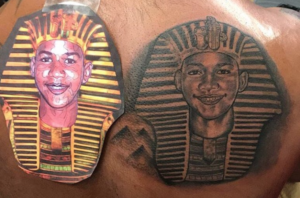“My body is my journal, and my tattoos are my story.” — Johnny Depp
Derrick Todd’s life has been marked by tragedy. His younger cousin was stricken by a car when waiting for the bus and died from complications. His brother was similarly killed, although under unknown circumstances to readers. As a young black man growing up in America, Todd’s life and identity are characterized not only by the deaths in his past, but the frame society controls black men under. Black men are often viewed on a bipolar scale, with the worst stereotypes depicting them as thugs, living on the streets and being intrinsically violent for no reason other than their skin color. On the opposite side, black men are fantasized, sexualized, and mysterious. In a world that has taken and taken from him, wrenching his beloved family members out of his life and trapping him in a self-fulfilling prophecy summoned by others, Todd turns to tattoos. No, not ‘I ♡ Mom’ or a girlfriend’s name. Todd symbolizes a litany of his life experiences, his past, and shared cultural meaning through the ink he permanently inscribes into his body. These tattoos truly are literary devices that connect Todd’s own life to the world and allows him to reclaim himself in a world that judges him before he even gets a chance to speak. His tattoos are usually simple despite their intricate meanings. Some of the tattoos he bears include eagle to symbolize his cousin’s strength, or the dog paying tribute to his late brother. While these are just symbols on the surface level, this ink penetrates far beyond the skin. Tattoos may be a permanent, static drawing, but they are just as alive as the rest of our bodies. Todd explains this best himself by simply saying, “As long as I got these [tattoos] on me, my cousin gon live forever, or at least as long as I live. He always gon be a part of me,” (Kirkland 384). These powerful statements force a cultural assessment of why we choose to get tattoos, what they represent both individually and as a collective whole, and what this means moving forward in terms of English education.

One of Todd’s tattoos. This represents his brother, who’s nickname was Boss.
Artistic expression is infinite. The very explosion of ways to express yourself artistically poses a challenge for modern education to keep up. This is particularly relevant when examining literature. Literature and English education are traditionally centered around grammar, rules, and guidelines, and are often slow to adapt to cultural changes. Education especially historically privileges some over others. The American education system has been dominated by cultural standards of whiteness as ‘normal’. This is a result of America culturally defining white as normal and good, whereas other races and cultures are viewed as different, and a disruption to the status quo. Because of this, we need new modes of education that are “not limited to technical, prescribed, or academic functions that privilege and serve only specific forms of texts and groups” (Kirkland 376).
Black men and their connection to literacy are essential here. A lack of literacy is interpreted as a lack of humanity, which then leads to black men being treated as less humane. However, black men are extremely literate, and Todd’s story highlights some of the intricate, modern ways that black men use literacy to resist the traditional system of suppression. Tattoos are a way to reclaim identity in a world that tells you who you are. This is particularly necessary for black men, who are so often defined by others. Reclaiming identity through tattoos is done on a personal and communal level. Tattoos clearly have deep personal meaning: through inking something permanent on our body, we create art that lasts with us forever. This art may connect to a challenge or struggle we overcame, or remind us of something we want to live by. The physical pain associated with a tattoo is also worth noting, as it serves as a reminder of the pain we’ve endured in our past and how we live and persist despite it. Tattoos also connect us to others and create shared meaning. Through tattooing memories of his late relatives, Todd feels connected to their memory and is able to let them live through him. Tattoos of course also allow us to process and understand life. Todd endured great pain and confusion when his family members were ripped from him. Todd is able to gain closure and insight through tattoos, because “In symbolizing his human story/struggle on flesh, Derrick participates in the human act of literacy that moves the personal closer to the transformative,” (Kirkland 386). A main function of literacy is to aid us in coping with tragic events. It also allows us to connect with the past and apply the lessons learned into the future and present. By tattooing himself, Todd will forever carry the memory of his fallen family members with him, holding the growth and transformation that came with it.
We must also fundamentally understand tattoos through a method of commenting. We live in a highly unstable and changing world, where forms of literacy like tattoos are viewed as ways to permanently stand in our identity (Weller). They also allow us to voice our frustrations and resist powerful systems. Todd’s tattoos of course have a personal and shared meaning, but they also pose a question: Why have all these young black men died? Why do we value their lives less than others? How come my brother, my cousin are just another statistic? When death and violence, especially against the black body, have become so normalized, a permanent symbol on our body is something we turn to. We may not be able to create major change in society just on our own, but we can resist and show we are actively participating in change through materializing those struggles in our body. A painful yet beautiful example can be seen on the back of Trayvon Martin’s father, Tracy Martin. Trayvon Martin was shot and killed by a neighborhood watchman in 2012 at the age of 17. When Tracy explained the tattoo, he said that “I just thought how my son had galvanized the country. To me, he’s a king […]. I thought it would be fitting to take it back to Ancient Egypt. Like, the sphinx is one of the wonders of the world. Trayvon was my wonder of the world,” (be Allah).

Tracy Martin’s tattoo of his late son, Trayvon.
What does this mean for English education? It means progressing towards increasing accessibility. Teachers must look for ways to include new and modern forms of literacy in their curriculum. This will require an open mindset from the teacher, but it will also flow easily from students. Teaching English in a way that incorporates tattoos among more youthful and nontraditional forms of English education will not go unrecognized by students, especially the students who are too often excluded from American education systems. Tattoos are literacy. They are ways to take back hijacked identities, to tell the world who you are, to connect to the world around you. But most importantly, exploring tattoos “give[s] us another way to search the human soul for its compassion and sacrifice and endurance,” (Kirkland 391).
*******************
Explanation of Blog Post
The reason I chose a blog post as my medium for explaining the article I selected is multifaceted. First, I knew I wanted to incorporate images. The article itself presented a litany of tattoos that connected to Derrick Todd’s story. While a video or timeline are able to present images, I particularly enjoy using the blog because of the role images play. With a blog, you must scroll through to read it, and images placed in the right places can be extremely impactful. By putting the beautiful image of Tracy Martin’s tattoo right after explaining the need for this tattoo, I am forcing the audience to pause and visually consider what I’m talking about. Images in a blog post garner the most impact because they serve to transition the blog while also creating a visual recognition in the audience. Second, I chose to use a blog post because of the tone used. One of the messages in this blog post was that English education needs to become more accessible for more audiences. A blog post allows you to bend the formal rules of an essay or academic paper while still staying within the mode of writing. I thought given the subject of my article, the tone of a blog post that can be more relaxed, open, and personal was perfect.
My main goals in this blog post were translating Kirkland’s thesis while putting my own personal touch on it. If the audience walks away with only one thing, I would want that message to be for them to open their minds. American society constrains us to labels of our identity and who we are, and I want the audience to walk understanding we can break through these labels, both personally and society, through exploring things like tattoos. There is such deep meaning in tattoos themself and the practice as a larger cultural use. Tattoos are literary devices that help us in gaining knowledge and understanding of a world that may be unknown to us. I am a white male, and while I am part of the LGBTQ+ community, I still enjoy a lot of the privilege that many throughout the world lack access to. I find it frustrating when white members of my community are unable to open the rest of the community to other cultures and be inclusive of all. Through this paper, I hoped to illustrate one of the ways those with privilege can understand and support those who don’t have the same power. Through showing the imagery of the tattoo of a dead son on his father’s back, something no one should have to endure, the audience has face-to-face connection with Trayvon Martin’s story. This may allow them insight and a perspective they had failed to consider before. When we hear about violence and people dying in society, it is often just another statistic. The painful imagery of his father reminds us that everyone who dies has a mother, a father, a family, friends, a life. They are not just statistics. Telling this story through the imagery of tattoos forces the audience to reconsider their previously held beliefs.
Finally, one of my main goals in this blog post was illustrating the need for education reform. Often, those who are in power of education and creating change fail to consider things from the perspective of students. I hope this post could be read by educators who will take away the idea that there are a litany of new literary devices in youth culture, many of which if incorporated into their curriculum would transform their classroom into an accessible space for all. Through sharing Derrick Todd’s intimate stories, I believe that an educator who would read my blog post would leave with the understanding of the impact of adapting their teaching to meet the needs of their students.


Recent Comments